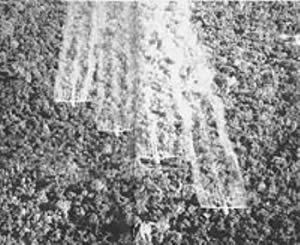Science of Conflict
Vietnam war -Agent Orange
Agent orange
was the name given to a very potent herbicide used by the U.S. military
in its war in Vietnam. This herbicide was used for ten years, from 1961
to 1971, to defoliate the forests of Vietnam and hence make the Viet con
(Vietnamese communists) visible from the air and to eradicate the enemies
food source by the destruction of crops. In total 24,000 Km2
or 6 million acres were sprayed in Vietnam.

Agent Orange
is a 1:1 mixture of two herbicides, 2,4-dichlorophenoxyacetic acid (2,4-D)
and
2,4,5-trichlorophenoxyacetic acid (2,4,5-T). These herbicides work on
broad leaf plants by mimicking growth hormones, which results in rapid,
uncontrolled growth and eventual death of the plant. These herbicides
were first developed in 1946 and were widely used in agriculture during
the 1950s.
During the Vietnam conflict many different types of herbicides were mixed with kerosene and sprayed from aircraft. Often the chemicals rained down on American, Australian and Vietnamese troops as well as civilians.
Many returned service men and women blame exposure to agent orange for the many illnesses suffered after the war. Illnesses such as cancer, mood swings, depression, skin problems and birth defects.Did the defoliation of millions of acres of forest assist in the war against the communist forces?
Research the lasting effects of Agent Orange and the impact on the local civilians that remains to this day.
Were adequate precautions taken during the spraying to protect the troops and civilians? Explain.
Can this be considered a case of chemical warfare?
Although the herbicides are relatively safe a byproduct of their manufacture is not. Dioxin or 2,3,7,8-tetrachlorodibenzo-para-dioxin (TCDD) pictured on the right, is produced as a byproduct of the manufacture of 2,4,5-T. Dioxin is a potent human carcinogen and as a consequence is banned in many countries.
